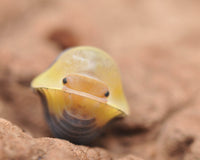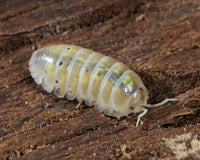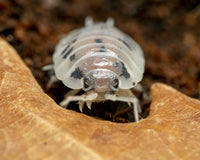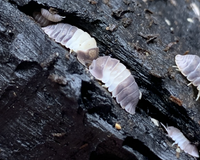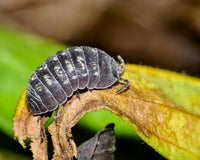So... YOU got Fungus Gnats. You started to build a Living Bio-Active soil substrate because you were told it was sooo much easier. Let our Team here at Rubber Ducky Isopods help you become a pro-active Isopod farmer.
Problems start when you try to build a healthy Isopod substrate from DIRT. The four letter dirty word that can cause havioc on a young and developing Isopod colony.
As your skillset begins to improve, building your Isopod soil substrates, one of the last significant issues you will need to face is soil compaction.
You also may occur anaerobic conditions from unhealthy or sluggish Isopod living soil substrates. One of the most common problems from an unhealthy soil substrate is known as the Fungus Gnat.
*Special Shout-Out To Matthew Gates (@Syncangel)
Managing The Fungus Gnat

Fungus Gnats have earned their reputation because they eat and thrive on a fungal organic matter diet. Since you are new to Isopod farming, we need to find a proper balance of decaying wood and plant material for our Isopods to thrive and manage undesirable additions from that decaying organic matter.
For the first few weeks of building our Isopod soil substrates, it was found that making the soil and feeding the microbes will cause the soil world to compete with the newly forming fungus gnat larvae. New living soil Isopod farmers typically over-water when beginning this unfamiliar Bio-Active substrate building style.
*Watch The Above Video To See Fungus Gnat Larvae From @Syncangel

New Isopod farmers cause their own problems by inherently over-watering their newly developing soil substrates. This allows the wet soil to be the perfect home for both fungus and decaying organic matter. The fungus gnat larvae eat the fungus or decaying matter and rely on the wet conditions to thrive.
After it has grown, the often invisible to the naked eye or overwatered matter has begun to decay within the topsoil. There, the fungus gnat lay their eggs, a problem faced by most Bio-Active living soil Isopod farmers.

During their seven to fourteen-day life span, females will lay up to 150 eggs with the living soil substrate. A well-built Isopod soil substrate contains high amounts of organic sphagnum peat moss and is particularly attractive to adult fungus gnat females.
With typical room temperatures, 68 to 78 degrees Fahrenheit, the life cycle (egg to adult) is complete within three to four weeks, allowing continuous reproduction year-round for indoor and greenhouse set-ups. Although fungus gnat adults do not bite, they become a considerable nuisance and help spread pathogens and degrade the overall health of your Isopod enclosures.
Fungus gnat larvae begin to thrive within the top 2 to 3 inches of the Isopod soil substrate. They primarily feed on decaying matter, algae and, fungi. However, these larvae will feed on plant roots and leaves found resting on the growing medium surface. Not only do these larvae develop rapidly, but they are also fully grown within just two to three weeks.
A critical understanding of a new Isopod farmer is that fungus gnats seem increasingly like a nuisance in the Vivarium and Terrarium worlds. However, below the surface, their larvae are wreaking havoc on the health and viability of the soil substrates you are trying to build for your tropical Isopods. (Cubaris sp loves a healthy and diverse microbial soil substrate)

Both adult and larval Fungus Gnats are known vectors of fungal pathogens. As a vector, these Fungus gnats open up new wounds for other common pests and diseases to take holds, such as Fusarium, Verticillium, and Pythium.
Furthermore, the newly acquired Fungus Gnat population may have come from unbalanced compost or store-bought soil blends found in boutique gardening centers.
Fusarium is a horrific plant pathogen that causes a severe disease known as Crown rot. Crown rot is caused by a soil-borne fungus that can survive in the soil indefinitely.
Next is a soil-borne pathogen that causes wilt and decay, known as Verticillium. This pathogen can live within the soil for years before finding water and then germinating. Once alive, it begins to eat at the Isopods cover crop root structure.
As the Verticillium starts to replicate, they infect part of the root world known as the xylem. The xylem system is responsible for transporting water throughout the cover crop plants, mostly clover and cilantro, beginning with the roots and watering up to the leaves.
As Verticillium starts to increase, it blocks the vessels within the xylem. As reproduction continues, they begin to produce toxins that travel up the xylem and other plant areas.
Finally, the most FEARED soil-borne fungus of all - pythium. Pythium, better known as "Root Rot," is a root zone parasite. It can often go unnoticed by the newer Isopod farmers until it has spread throughout the soil substrate's entirety.
Of course, by then, the Pythium has already begun destroying the cover crops plant's root structure on a microscopic level. Above the soil, symptoms are not visible by the naked eye until a tremendous amount of damage has ALREADY taken place.

How do we learn to face and combat this problem from the start so that, as an educated Isopod farmer, we can improve and protect our Isopods using Mother Nature? The answer is Bio-Active Living Soil substrates that focus on a healthy closed-loop Isopod vivarium system.
By learning to build our thriving microbial ecosystem, inoculating certain soil-dwelling species into the living soil Isopod substrates is beneficial not only for the Isopods cover crop but for the ecosystem that it thrives in.
To do this, the species that are beneficial for a more biological approach to our Integrated Pest Management (IPM) system need to be identified.
Welcome to the magical world of beneficial predators and how we use Mother Nature to combat any issues that could arise when Isopod farming.
Rove Beetles

This Apex soil predator is the go-to for the eradication of the fungus gnat and the fungus gnat larvae! Rove beetles are well known to feed on small soil-dwelling pest eggs and larvae, thus decreasing new fungus gnats' growth. They develop from egg to adult in just 21 days! When the rove beetle reaches maturity, they typically eradicate around 150 fungus gnats per day.
Adults are brown or black, typically 3-4 millimeters long, and are winged. One of the only downfalls of this beneficial predator is that the rove beetle is relatively expensive for more extensive Isopod cultivation facilities to invest in. As intelligent Isopod farmers, how do we combat this? We learn to breed and farm these robust Rove Beetles on our own.
Only 3 ingredients are needed to begin to farm rove beetles:
- First, create a mixture blend of 60% organic sphagnum peat moss and 40% rice hulls.
- Next, mist the new mixture and place it into 3/4 of the container being used.
- Then, add 1/2 cup of oatmeal and 1/4 cup of water and put the oatmeal into the container's reaming 1/4.
- Finally, add 25-50 rove beetles to the newly mixed substrate.
Let this substrate sit for a few weeks, and shortly after, the larvae will begin to appear underneath the oatmeal. Within a month, the population will have at least doubled in size, a simple fix for large and small cultivation facilities.
To increase the rove beetle's population's volume and speed, the Isopod farmer needs to increase the number of substrates created. Then, the rove beetle works in a symbiotic relationship with the Stratiolaelaps scimitus, widely known in the Isopod world as the "H Miles Predatory Mite."
*Watch The Above Video To Watch A RARE VIDEO From @Syncangel
Hypoaspis Miles

Stratiolaelaps scimitus, better known as the Fungus Gnat Predator, begins to dominate the top layer within a living soil bed where the dreaded larvae and pupae live. Populations of Hypoaspis include both sexes, but the males are much smaller and rarely seen. Both males and females inhabit only the top few centimeters of soil. Under a simple microscope, most stages of this mite appear similar.
Eggs hatch in about 2-3 days, and the life cycle is complete in around eleven days. These predatory mites feed upon the young larvae of fungus gnats in the soil and are most effective when applied to the soil before the fungus gnat populations are established. Hypoaspis consume 1-5 prey per day and survive as a scavenger by feeding on algae and plant debris.
Beneficial Nematodes

Steinernema Feltiae Nematodes are the strain best suited for Isopod farmers wanting to use a Bio-Active Living Soil substrate. When using these "living soil defenders," beneficial nematodes are of interest because of their ability to protect against fungus gnats for about 18 months. Once added to the soil, the beneficial nematodes locate pests and enter through various body openings or the body wall.
After they have entered the host pest, they inject bacteria into the pest's blood. This bacteria creates food and builds a friendlier environment for its reproduction needs. As food begins to run out of the host pest, the nematodes will move onto a brand new host. The nematodes will continue to be ruthless and do this until they have exhausted their food source.








